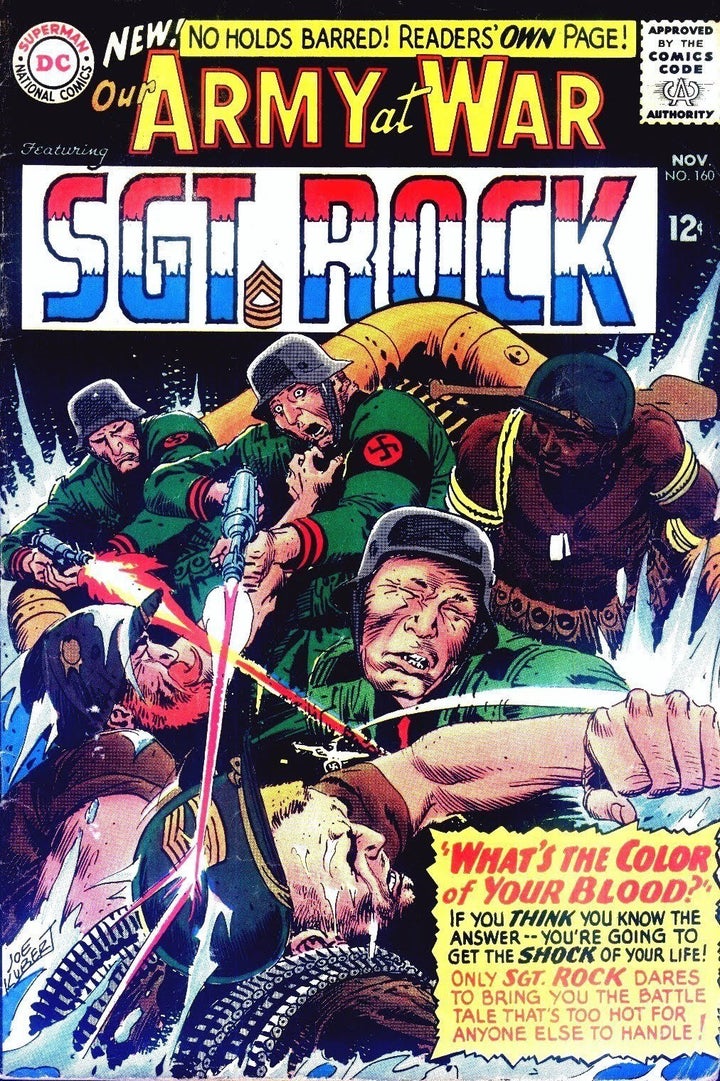
A living legend of comic books died last weekend.
Joe Kubert was the one of the most influential, prolific, long lasting and last of the greats of the founding generation of comic books. By all accounts he was also one of the nicest guys you'd ever want to meet, renowned for his firm handshake. His award winning career lasted from his early teens right up to his death at age 85 on August 12.
Among his many achievements as an extraordinarily skilled artist, Kubert most famously put a human face on war. The face was that of Sgt. Rock of Easy Co., in stories principally written by long time collaborator Robert Kanigher and published from the 1950s through the 1980s, for a time even outselling DC comics' powerhouse superheroes Superman and Batman.
Kubert's art etched the weariness of the war-weary into Rock's face: a triangular face looking haggard and suggesting gauntness without quite getting there that narrowed down from his helmet, its strap undone and flapping, to a jutting jaw with a permanent stubble of beard and, most striking of all, the dark shadows of his recessed eyes.
In the bend of the shoulders and the slight buckle of the legs one felt the weight of what Rock carried: the grenades and ammunition belt that always hung on him, the rifle in his hands, and the responsibility for the lives of the men under his command. The powerful humanity of Sgt. Rock accounts for his popularity even at the height of the opposition to the Vietnam War. As an editor at DC during that time he inserted at the end of each war story the slogan "Make War No More." "I wanted to make it clear that, despite the fact that I was editing war books, we were not glorifying war," Kubert explained. I have him to thank for developing my ability to distinguish the war from the warrior when I think about our foreign policy and our troops in combat.
Kubert's later graphic novels took up war and violence more seriously. Yossel: April 19, 1943 movingly illustrates what his life might have been like had he not escaped from his native Poland and ended up in the Warsaw ghetto during the Holocaust. His imaginatively similar Jew Gangster is Kubert's version of what his life might have been like had he not escaped the poverty and crime of the Brooklyn neighborhood where he grew up. Fax from Sarajevo tells the story of the brutal siege of that Bosnian city through the lens of faxes sent out by a Muslim friend trapped there.
Kubert declares his motivation on the book's front overleaf: "In 1945, we told the world, 'Never again.' In 1992, we forgot our promise." Later he joined other comics greats Stan Lee and Neil Adams to create a short comics story as part of an international campaign to prod the Auschwitz Museum to return to Dina Gottliebova (Babbitt) drawings they had on display that she'd been forced to produce as a prisoner there. The fictional and factual streams of his work met when in the 2006 miniseries The Prophecy Rock and Easy Company finally directly encountered the Holocaust. When I asked him in an interview why it took so long he replied that back then there was a "tacit understanding" that such things were inappropriate for the comic book audience. Kubert worked to raise the intelligence level of comics, and was one of the first to produce graphic novels aimed at a more adult audience.
His most long lasting contributions may not yet have been felt. He was a great teacher; in 1976 he and his wife Muriel co-founded the Joe Kubert School of Cartoon and Graphic Art in Dover, New Jersey, the first accredited school dedicated entirely to "the art of cartoon graphics," from which have come many of today's leading comics artists. Among the graduates are Kubert's sons Adam and Andy, now both well respected comics artists in their own right.
After Sgt. Rock, Kubert is most associated with the characters of Hawkman, whom he first drew in his original 40s incarnation and then in his 60s revival, Tarzan, and Tor, a prehistoric hunter of his own creation. Among the most sparsely clothed comic heroes (well, among the men anyway) they all allowed Kubert to showcase his remarkable ability to imbue the human body with great grace and power.
The extraordinary fluidity and economy of Kubert's line allowed him to condense the energy of action into subtle fluctuations of the body in motion, capturing the precise moment at which the action's about to kick into high gear. He was comics' most sought after cover artist because that's precisely what would draw viewers in, the heightened sense of anticipation he created pointing forward to what's going to happen next.
That's part of the great loss here. There'll be no more next.
This essay draws on Harry Brod's Superman is Jewish?: How Comic Book Superheroes Came to Serve Truth, Justice and the Jewish-American Way, to be published in November by Free Press.